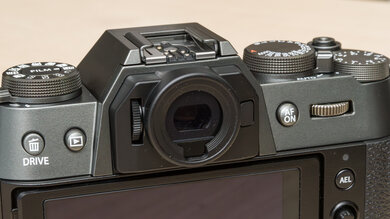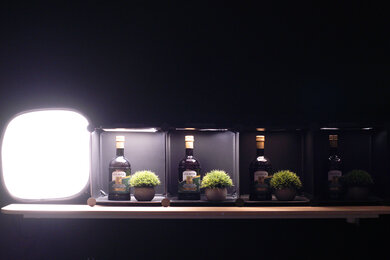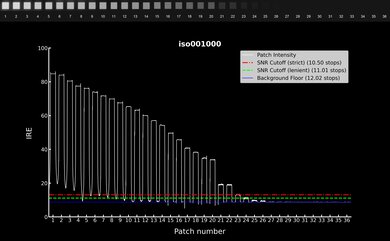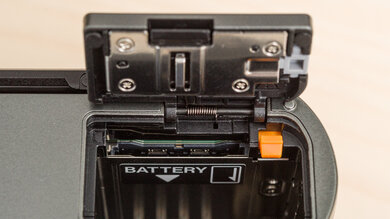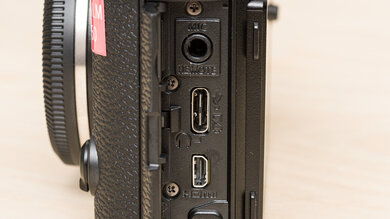The Fujifilm X-T50 is a mid-range mirrorless camera and the follow-up to 2021's Fujifilm X-T30 II. With a redesigned body and a new 40.2-megapixel sensor, it offers some key improvements for anyone looking for a more compact alternative to the Fujifilm X-T5 or upgrading from an older model. It's also the first model in the double-digit X-T series to feature in-body image stabilization (IBIS), which is great for video or low-light shooting. But with a significantly steeper price tag than previous models in the series, it's also a tougher sell as an entry-level model.
Our Verdict
The Fujifilm X-T50 is great for travel photography. It's remarkably compact for an interchangeable-lens model, with solid ergonomics and well-thought-out controls for its size. It even has an IBIS system, which can help you capture steadier shots at slow shutter speeds. Image quality out of its high-resolution sensor is amazing, and its dedicated film simulation dial makes it fun and easy to change up the look of your JPEG images. That being said, its battery life is nothing to write home about, and while it's a well-built camera, there's no weather-sealing, so you'll have to be a bit more careful in adverse weather conditions.
-
Exceptionally high-resolution sensor.
-
Highly portable body.
-
In-body image stabilization.
-
Autofocus tracks moving subjects fairly well.
-
Ergonomics can feel cramped if you have larger hands.
-
Battery life is middling.
The Fujifilm X-T50 is great for landscape photography. It has a high resolution APS-C sensor that gives you plenty of leeway to crop in your images if needed. Plus, it has excellent dynamic range, preserving a wide range of detail in high-contrast landscapes. On top of that, it's a remarkably portable camera body, though that does mean the ergonomics can feel a bit cramped for those with larger hands. Its battery life also leaves something to be desired.
-
Exceptionally high-resolution sensor.
-
Highly portable body.
-
In-body image stabilization.
-
Excellent dynamic range.
-
Ergonomics can feel cramped if you have larger hands.
-
Battery life is middling.
The Fujifilm X-T50 is good for sports and wildlife photography. While it doesn't have the fastest burst rate, it can still shoot at respectable speeds, especially when using its electronic shutter mode. That said, it doesn't have the fastest readout speed, so you're more likely to encounter artifacts with moving subjects in that mode. Its autofocus system performs reasonably well at tracking and focusing on moving subjects, but it still has a bit of trouble with more erratic subjects or in busier settings. Thankfully, image quality is excellent, and it's very portable, but its ergonomics can feel cramped for those with bigger hands.
-
Exceptionally high-resolution sensor.
-
Highly portable body.
-
Autofocus tracks moving subjects fairly well.
-
Quick e-shutter burst shooting.
-
Ergonomics can feel cramped if you have larger hands.
-
Battery life is middling.
-
Small RAW image buffer.
-
Mechanical burst rate is on the slower side.
The Fujifilm X-T50 is decent for vlogging, though it's primarily a photography camera. There's no flip-out screen, so you can't really monitor yourself easily while recording. However, it does offer advanced video capabilities, like 6k recording and 4k at up to 60 fps. Its autofocus system also performs very well in video mode, ensuring you or your subjects don't slip out of focus too much. Unfortunately, in its highest-quality settings, the camera has pretty intolerable rolling shutter distortion.
-
Highly portable body.
-
In-body image stabilization.
-
Autofocus tracks moving subjects fairly well.
-
Records at up to 6.2k 30 fps.
-
Battery life is middling.
-
Terrible rolling shutter effect at highest quality settings.
-
Tilting screen doesn't flip around.
-
Ergonomics are not designed for videography.
The Fujifilm X-T50 is a very capable video camera, though it's designed primarily for photography. Its ergonomics aren't really made for videography, with a tilting screen and compact form factor with minimal handgrip. There's also no headphone jack to monitor your audio, though Fujifilm does include a USB-C-to-headphone adapter in the box. With that said, the camera does offer some pretty advanced video capabilities, including internal Log recording and 10-bit 4:2:2 color, so it's well-suited as a compact B-roll camera. Unfortunately, though, its internal battery life is quite limited for video recording, so you may need an external power supply for longer sessions.
-
Records at up to 6.2k 30 fps.
-
Internal 10-bit 4:2:2 color.
-
Log recording in F-Log and F-Log 2.
-
Battery life is middling.
-
Terrible rolling shutter effect at highest quality settings.
-
Ergonomics are not designed for videography.
The Fujifilm X-T50 isn't meant for POV action video, but it works well to capture footage of action from the sidelines. It has a fairly wide range of frame rate options, including 4k at up to 60 fps with a slight crop and a slow-motion recording mode in 1080p that goes up to 240 fps. IBIS can help smooth out camera shake, but, unfortunately, the camera isn't weather-sealed, and its ergonomics aren't really designed for video recording.
-
Highly portable body.
-
In-body image stabilization.
-
Dedicated slow-motion recording mode in 1080p.
-
Battery life is middling.
-
Terrible rolling shutter effect at highest quality settings.
-
Ergonomics are not designed for videography.
The Fujifilm X-T50 has great RAW image quality. It has excellent dynamic range to preserve a wide array of highlight and shadow detail in high-contrast scenes. Its exceptionally high resolution also captures plenty of fine detail and gives you leeway to crop. However, its low-light noise handling is only decent.
-
Exceptionally high-resolution sensor.
-
Excellent dynamic range.
-
Noise handling is only decent.
- 7.9 Travel Photography
- 8.1 Landscape Photography
- 7.6 Sport & Wildlife Photography
- 7.1 Vlogging
- 8.5 Studio Video
- 6.1 Action Video
Performance Usages
- 8.0 Raw Photo
Changelog
-
Updated Feb 12, 2025:
We wrote text for the new tests added in Test Bench 0.13.
- Updated Feb 03, 2025: We've converted this review to Test Bench 0.13. We've added new tests for Video Dynamic Range and Luminosity Patch Detection. You can learn more about these updates in the changelog.
-
Updated Jan 16, 2025:
We added a comparison to the Fujifilm X-M5 in the Portability section.
- Updated Aug 20, 2024: Review published.
- Updated Aug 13, 2024: Early access published.
Check Price
Differences Between Sizes And Variants
The Fujifilm X-T50 comes in three colorways: Black, Silver, and Charcoal Silver. We purchased the Charcoal Silver model, and you can see our unit's label here.
You can buy the camera body on its own or bundled with either the FUJINON XC 15-45mm f/3.5-5.6 OIS PZ lens or the FUJINON XF 16-50mm f/2.8-4.8 R LM WR lens.
Popular Cameras Comparisons
The Fujifilm X-T50 is a mid-range mirrorless camera. If you like what the Fujifilm X-T5 has to offer, but prefer a much more portable body, this is the camera for you. Its compact size and dedicated film simulation dial make it a fun camera to shoot with, and the inclusion of IBIS on a double-digit X-T camera is a welcome addition. It also significantly improves upon the video capabilities of its predecessors. However, at this price point, it's a bit questionable as a hybrid option, with an alternative like the Fujifilm X-S20 offering many of the same video features with a lower price tag and a body that's better suited to video work.
For other options, check out our picks for the best mirrorless cameras for travel, the best cameras for beginners, and the best digital cameras we've tested overall.
The Fujifilm X-T50 is the successor to the Fujifilm X-T30 II. The X-T50 offers a few major updates, including an in-body image stabilization system, a higher-resolution sensor, better autofocus, better video features, and a slightly redesigned body with better ergonomics. That being said, it also sits at a significantly higher price point. So, while the X-T50 is clearly the winner here, it may not be the best-value choice for some people, especially if you don't need the advanced video capabilities it offers.
The Fujifilm X-S20 and the Fujifilm X-T50 are both great mid-range models from Fujifilm, but they're aimed at different users. The X-T50 has a more photography-oriented design, with a compact body and more control dials, in addition to a higher-resolution sensor that's better suited to photography. The X-S20, on the other hand, has better ergonomics overall, and its articulating screen and simpler PSAM dial lend themselves better to video work.
The Sony α6700 and the Fujifilm X-T50 are both mid-range mirrorless cameras. If you prioritize ergonomics, the Sony is the better option, with a more substantial grip that makes it feel more comfortable to shoot with. It's also a bit more suited to video work, with a fully articulated screen and more frame rate options. However, if you're looking for a more portable and fun-to-use camera with a higher-resolution sensor for photography, get the Fujifilm.
The Fujifilm X-T50 is like a mini version of the Fujifilm X-T5. Each camera uses the same high-resolution APS-C sensor, so image quality is comparable, but they offer different shooting experiences and ergonomics. If you're looking for a more portable camera for travel or street photography, the X-T50 has an advantage. However, the X-T5 is more robust, with more control dials, a higher-resolution viewfinder, a bigger battery, and dual SD card slots.
The Fujifilm X-T50 is better than the Fujifilm X-M5. While they're both very portable models in Fujifilm's lineup, the X-T50 has a higher-resolution sensor as well as features like a viewfinder and in-body image stabilization that make it more well-rounded. That said, if you need a very compact interchangeable lens camera, the X-M5 is a bit smaller.
Test Results
The Fujifilm X-T50 is highly portable for an interchangeable lens camera. It's a tad bigger than its predecessor, but given the addition of an IBIS system, as well as a larger handgrip for better ergonomics, it's still impressively compact. It's also a very lightweight camera body, making it easy to take on the go. If you want an even more portable camera, check out the Fujifilm X-M5.
The Fujifilm X-T50 has good ergonomics for its size. Fujifilm redesigned the body in a few key ways compared to the Fujifilm X-T30 II. The body is slightly more rounded, with a more substantial handgrip, making it feel more comfortable in the hand. The 'Q' or quick menu button is a bit more out of the way now, with a thumb rest that's angled out more, so you're less likely to accidentally press it. All of these improvements add up to make the camera more suitable for those with larger hands, although the camera may still feel cramped for some. In general, though, the buttons and dials feel well-placed, given the camera's small size. The front and rear command dials are also pressable, giving you plenty of manual control, and the dedicated shutter speed dial also includes a switch that lets beginner shooters flip the camera quickly into Auto mode.
Rather than a drive mode dial, however, the X-T50 includes a dedicated 'Film Simulation' dial, as you can see on the left here. It lets you choose from between eight of the total 20 film sims--including the new Reala Ace profile--as well as up to three custom film sims, and the 'C' setting, which lets you choose from all 20 profiles in the camera menu. You can see which film simulation is active through the viewfinder when you turn the dial, as seen here, and you can get further info, like so when you press the Q button.
The choice to have a dedicated film simulation dial is interesting and something Fujifilm hasn't done before. Whether you prefer to have easier access to different film simulations or easier access to different drive modes is really up to the user and their needs, but it definitely positions the camera more towards beginners and intermediate shooters and those who prefer to share JPEG images straight out of camera.
The electronic viewfinder (EVF) is one thing that hasn't really changed. It has a pretty standard resolution, so you'll have a reasonably sharp image through the viewfinder, but it's nothing special in a market with increasingly higher-resolution EVFs. It's also quite small, and the plastic eyecup isn't especially comfortable.
The tilting screen is great for waist-level shooting and gets bright enough to overcome glare on sunny days. It has a slightly higher resolution than the screen on the Fujifilm X-T30 II, and it delivers a very crisp image. You can use touch functionality to activate the shutter, select the focus point, and enable AF tracking, as well as for playback, but you can't use it to scroll the menu.
The menu system is quite good overall but isn't the most intuitive at first. Some of Fujifilm's terminology also differs from other brands, like metering settings being labeled 'Photometry.' Overall, it's easy to navigate, especially once you get used to it, but it can be a little cumbersome to get through all the sub-menus to find what you're looking for. Like the Fujifilm X-T5 and Fujifilm X100VI, there's now a video-specific menu when using video mode, as you can see here, making it easier to access relevant video settings. Thankfully, there are also plenty of customization options, including 'My Menu' pages to access your most frequently used settings and the quick menu that you can pull up while shooting.
The Fujifilm X-T50 uses the same high-resolution X-Trans V sensor and X-Processor 5 as other current-gen Fuji cameras like the Fujifilm X-T5, Fujifilm X-H2, and Fujifilm X100VI. It's advertised to have an improved pixel structure for more efficient light-gathering, as well as a lower native base ISO.
The Fujifilm X-T50 has an okay battery life. It's CIPA-rated for 305 photos on a full charge or 390 photos when using the camera's battery-saving 'Economy' mode. However, CIPA ratings differ from real-life usage, so your mileage will vary depending on your settings and use.
In video mode, the camera's battery performance isn't great. We managed to record continuously for over an hour, using the 4k HQ setting at 30 fps, but the camera overheated once after about 45 mins. Fujifilm advertises a battery life of 45 minutes in 4k HQ at 60 fps and about 120 minutes in FHD at 120 fps. If you need to extend the battery life, you can use an external power supply.
The Fujifilm X-T50 can shoot at fairly quick burst speeds, with a max mechanical burst rate of eight fps and a max electronic burst rate of 20 fps, although shooting at 20 fps incurs a 1.29x crop. Otherwise, it can shoot at a max electronic shutter burst rate of 13 fps without a crop. When shooting RAW files, the buffer fills up after about 20 frames, which is quite small but still a slight improvement over the Fujifilm X-T30 II. The buffer also takes a fair amount of time to empty, which can slow you down at a critical moment. When shooting in JPEG, however, you can shoot indefinitely without the camera slowing down.
The Fujifilm X-T50 uses the latest iteration of Fuji's autofocus system. It's an improvement over the older system, with a wide range of subject detection modes. That includes Animal (cats and dogs), Bird (birds and insects), Automobile, Motorcycle (bikes and motorcycles), Airplane (airplanes and drones), and Train. In addition, it supports human face and eye tracking. However, the interface isn't the most intuitive, with the subject detection modes separate from the human face/eye detection, meaning an extra step if you want to quickly switch from tracking a human subject to a vehicle or bird, for example.
Overall, the AF-C tracking performs reasonably well. It's less consistent than higher-end models like the Fujifilm X-T5, but it's a noticeable step up from the Fujifilm X-T30 II, with a much higher rate of keepers. With faster subjects, it can be a bit slow to stay with the subject, especially in busier environments, but it isn't bad by any means.
Another big upgrade compared to the Fujifilm X-T30 II is the addition of in-body image stabilization, which should help when shooting at slower shutter speeds. We managed to get clear handheld images at very slow shutter speeds, though the camera's light weight means less inertia than heavier cameras. Of course, stability depends on many factors, including what lens you use, the focal length you shoot at, and how steady your hands are. We performed this test using the XF 16-50mm f/2.8-4.8 R LM WR lens, which doesn't have optical stabilization (OIS).
The Fujifilm X-T50 has excellent usable dynamic range, especially at its base ISO. It captures a wide array of highlight and shadow detail, making it well-suited to high-contrast scenes.
The camera resolves a great amount of fine detail, thanks to its 40.2 megapixel sensor. You have quite a bit of leeway to crop in your photos without losing too much visible sharpness.
The camera does a decent job of managing noise levels in low-light situations. It's about on par with the Fujifilm X-T5, and considering the high resolution of its sensor, it retains quite a bit of detail in low light.
The Fujifilm X-T50 boasts some advanced video features, especially compared to older models in the series. It supports Log recording in both F-Log and F-Log 2 to preserve a wider dynamic range in video. It can also output 10-bit 4:2:2 video via HDMI and can even output 6.2k RAW video at up to 30 fps when paired with a compatible external recorder. Internally, it can capture both 6.2k and oversampled '4k HQ' at up to 30 fps as well, but both of these resolutions incur a 1.23x crop.
Note that the option to shoot in MP4 is available for every resolution except 6.2k, which is only available in MOV format. When shooting in MP4, the camera is also limited to H.264 LongGOP, with 4:2:0 chroma sampling.
In its default 4k mode, the Fujifilm X-T50 can record at up to 60 fps. The 60 fps setting incurs a slight 1.14x crop. When you switch over to the oversampled 4k HQ, or 6.2k recording, it can only shoot in 24 or 30 fps, with a 1.23x crop. Despite the cropping, that's still very solid and a step up from the older Fujifilm X-T30 II, giving you more options for high-quality slow-motion capture.
The camera has excellent internal recording specs. It can capture high bit rates, supports Log recording, and gives you the option to record in 10-bit 4:2:2 color if you need more flexibility to grade and process your videos. There are also no recording time limits. All of this is becoming the norm these days, even on mid-range models like this one. That being said, while the camera is a major improvement in heat management compared to the Fujifilm X-T30 II, it can still overheat with very long recording sessions.
The autofocus works remarkably well for video. It has very little trouble tracking and keeping moving subjects in focus, with quick, responsive transitions for the most part. We achieved the results above using the oversampled 4k HQ mode, which performs a bit better than the default 4k mode.
In addition to human face/eye detection, you can choose between different subject detection modes, including Animal, Bird, Automobile, Motorcycle, Airplane, or Train. With continuous autofocus, you can choose between two area modes: 'Multi,' which automatically detects and tracks a subject in the frame, and 'Wide/Tracking,' which gives you a smaller moveable focus point and tracks a given subject that falls within that focus area.
The camera's 4k video quality is fantastic when using the oversampled 4k HQ mode. Although it comes with a crop, the image is crisp and detailed, and the camera performs well even in low light.
You can compare the 4k HQ test scene extract above with the default 4k resolution at 30 fps here and at 60 fps with the 1.14x crop here. You can also compare it to 6.2k at 30 fps here. It's worth noting that enabling the camera's digital stabilization feature incurs an additional 1.1x crop, as you can see at 30 fps here and at 60 fps here.
Unfortunately, the Fujifilm X-T50 has terrible rolling shutter distortion when shooting in either 4k HQ or 6.2k (which you can see here. The readout speed just isn't fast enough, resulting in very heavy skewing with vertical lines when panning and wobbling with back-and-forth movements. That being said, the default 4k mode is a lot better in that regard, with a rolling shutter angle of 6.33º. There's still noticeable skewing with faster camera movements, but it's more manageable, as you can see here.
The camera can record standard FHD video at up to 60 fps, with a high-speed recording mode that can capture slow-motion video with no audio at up to 240 fps. Regular 60 fps incurs a slight 1.14x crop, whereas the high-speed recording mode incurs a larger 1.23x crop. All in all, you have a wide range of options for varying degrees of slow-motion recording in 1080p.
The camera has excellent internal recording specs. It can capture high bit rates, supports Log recording, and gives you the option to record in 10-bit 4:2:2 if you need more flexibility to grade and process your videos. There are also no recording time limits.
The camera's autofocus is great when shooting in 1080p. It's less reliable than it is in 4k HQ, but overall it still keeps up with moving subjects well, though some focus transitions can still be a bit sluggish or jumpy.
The camera's 1080p video quality is great, especially in more controlled lighting conditions. It looks reasonably sharp, with good detail preservation, but naturally, you'll see some noise and loss of detail in low light.
Image quality noticeably degrades when using the slow-motion recording mode. You can see a sample test scene extract from a slow-motion FHD at 240 fps recording here. You can also see how the standard 30 fps recording compares to an FHD 60 fps extract here. It's also worth noting that enabling the digital stabilization feature incurs an additional 1.1x crop, as you can see at 30 fps here or 60 fps here.
Rolling shutter effect is less noticeable in FHD, especially compared to the higher-quality 4k HQ and 6.2k modes, but there's still a bit of skewing and wobbling with faster camera movements.
The Fujifilm X-T50 has great video dynamic range. It doesn't capture as many stops above the background floor as other models, like the Fujifilm X-T5, so you'll have less room to recover shadow detail in post. Overall, though, it has a very good usable dynamic range, capturing a fairly wide ratio of highlights to shadows.
Tested Settings:
- Resolution: 4k
- Frame Rate: 30 fps
- Log Format: F-Log2
Though the camera's ISO range is somewhat limited in F-Log2, with a base ISO of 1000, its dynamic range is quite consistent. It preserves highlight detail well but has less range in the shadows than the Fujifilm X-M5, for example.
Tested Settings:
- Resolution: 4k
- Frame Rate: 30 fps
- Log Format: F-Log2
While the Fujifilm X-T50 is still limited to a single SD card slot, it now takes faster UHS-II cards, which is fitting for those higher-resolution files. The slot is located inside the battery compartment on the bottom of the camera, so it's harder to switch out cards when using a tripod.
The Fujifilm X-T50 has a fairly typical suite of inputs and outputs. To be expected for a camera of this size, there's only a Micro HDMI port, but the 2.5mm microphone input of previous models in the series has been upgraded to a more common 3.5mm input, which is nice. There's no headphone jack to go with it, but the camera does come with a USB-C to 3.5mm headphone adapter in the box. Otherwise, you can use the USB-C port for charging, power supply, and file transfer.
Comments
Fujifilm X-T50: Main Discussion
Let us know why you want us to review the product here, or encourage others to vote for this product.
This product has been merged with Fujifilm X-T50 Mirrorless Camera with XF 16-50mm f/2.8. Follow the discussion here.
- 21010
Hello there! It’d be great to understand the differences with the X-T30 II considering the price difference
Hey there tatelucas! I have created a comparison for you to help with recognizing the differences between the 2 cameras.
Side by side x-t50 vs x-t30 ii
Some of the bigger adjustments made to the x-t50 are:
Higher resolution sensor Improved ergonomics Addition of in body image stabilization (ibis) Newer film simulations Improved autofocus performance, with more options for subject tracking Improved video recording performance and higher video specs (and no more recording limits)
Check out the side by side and let us know if you have any more questions! Thanks and have a great one!
Edited 8 months ago: edited link The full review has been posted here. Let us know what you think!
- 21010
Hello there! It’d be great to understand the differences with the X-T30 II considering the price difference
Early access to our full test results is now available for Insiders! Become an insider to check it out here.







